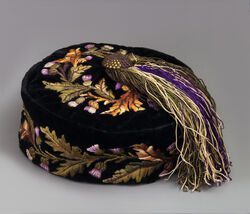Smoking cap
June 2022

The great importance of smoking in the nineteenth century is reflected in the exuberant tobacco pipes that were made in that period. But the culture of smoking went further. Some Nicotinists even bought a costume to emphasize the exotic atmosphere of their hobby, but also for practical reasons. At home you didn't have to be so formally dressed so you used a long embroidered housecoat. A flat, cylindrical velvet hat completed that outfit. All that velvet absorbed the nicotine from the pipe and later the cigar. During dinner a dinner jacket was worn, a dress suit with a white bow. For the cognac and a smoke, the gentlemen went to the library, billiard room or special smoking room, the ladies retired to the drawing room for a cup of tea. The men then changed their dinner jacket for the smoking jacket, a short velvet jacket and put on their smokers' caps. They enjoyed their pipe, cigar, brandy and conversations. At the end of the evening they changed their jackets again so that the ladies would not be disturbed by the heavy tobacco smoke that had surrounded the men. So the smokers' outfit had a useful function. A smoking cap or kalot in proper Dutch is therefore a special hat with a cylindrical shape and a flattened top with a large tassel hanging from a decorative button. It is derived from the Turkish fez. Such hats are provided with beautiful embroidery in countless colors all around. That such caps were highly valued is apparent from the special leather hat box in which it was delivered to transport and store the hat. The fact that a single hat box even bears an owner's initials proves that these boxes were so standard that they had to be distinct from one another in public places. Apparently they were worn not only in the intimacy of one's own home, but also in societies. At the gentlemen's club, there might have been a dozen boxes on the coat rack.
Amsterdam Pipe Museum APM 24.490a
Permalink